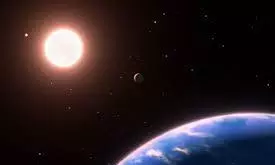
NASA's Hubble Telescope discovers water vapour in atmosphere of exoplanet
text_fieldsAstronomers utilising NASA's Hubble Space Telescope have identified water molecules in the atmosphere of a small exoplanet named GJ 9827d, located 97 light-years away from Earth.
This blazing-hot planet, approximately twice the diameter of Earth, presents a unique opportunity to study potential planets with water-rich atmospheres in our galaxy.
"This would be the first time that we can directly show through atmospheric detection that these planets with water-rich atmospheres can exist around other stars," said Bjorn Benneke of the Trottier Institute for Research on Exoplanets at Universite de Montreal. "This is an important step toward determining the prevalence and diversity of atmospheres on rocky planets."
Co-principal investigator Laura Kreidberg of Max Planck Institute for Astronomy in Heidelberg, Germany, highlighted the significance of this discovery, stating, "Water on a planet this small is a landmark discovery. It pushes closer than ever to characterising truly Earth-like worlds."
Despite the potential for water, the harsh temperatures on GJ 9827d make it an inhospitable environment for life. Researchers are still working to unravel the mysteries of this unusual world's atmosphere.
The findings, detailed in a report published in The Astrophysical Journal Letters on Thursday, raise questions about the nature of the planet's atmosphere. It remains uncertain whether Hubble detected water vapour within a hydrogen-rich atmosphere or if the host star caused GJ 9827d to lose its original hydrogen and helium atmosphere, leaving behind a water-rich atmosphere.
"Our observing program was designed specifically to not only detect the molecules in the planet's atmosphere but to look specifically for water vapour," explained Pierre-Alexis Roy of the Trottier Institute for Research on Exoplanets at Universite de Montreal.
At 800 degrees Fahrenheit, GJ 9827d is as hot as Venus, making it a steamy world if the atmosphere is predominantly water vapour. The research team is considering two possibilities – GJ 9827d could either retain a hydrogen-rich atmosphere with traces of water, resembling a mini-Neptune, or it may be a warmer version of Jupiter's moon Europa, potentially composed of half water and half rock.
"This planet could be half water, half rock. And there would be a lot of water vapour on top of some smaller rocky body," added Benneke.























